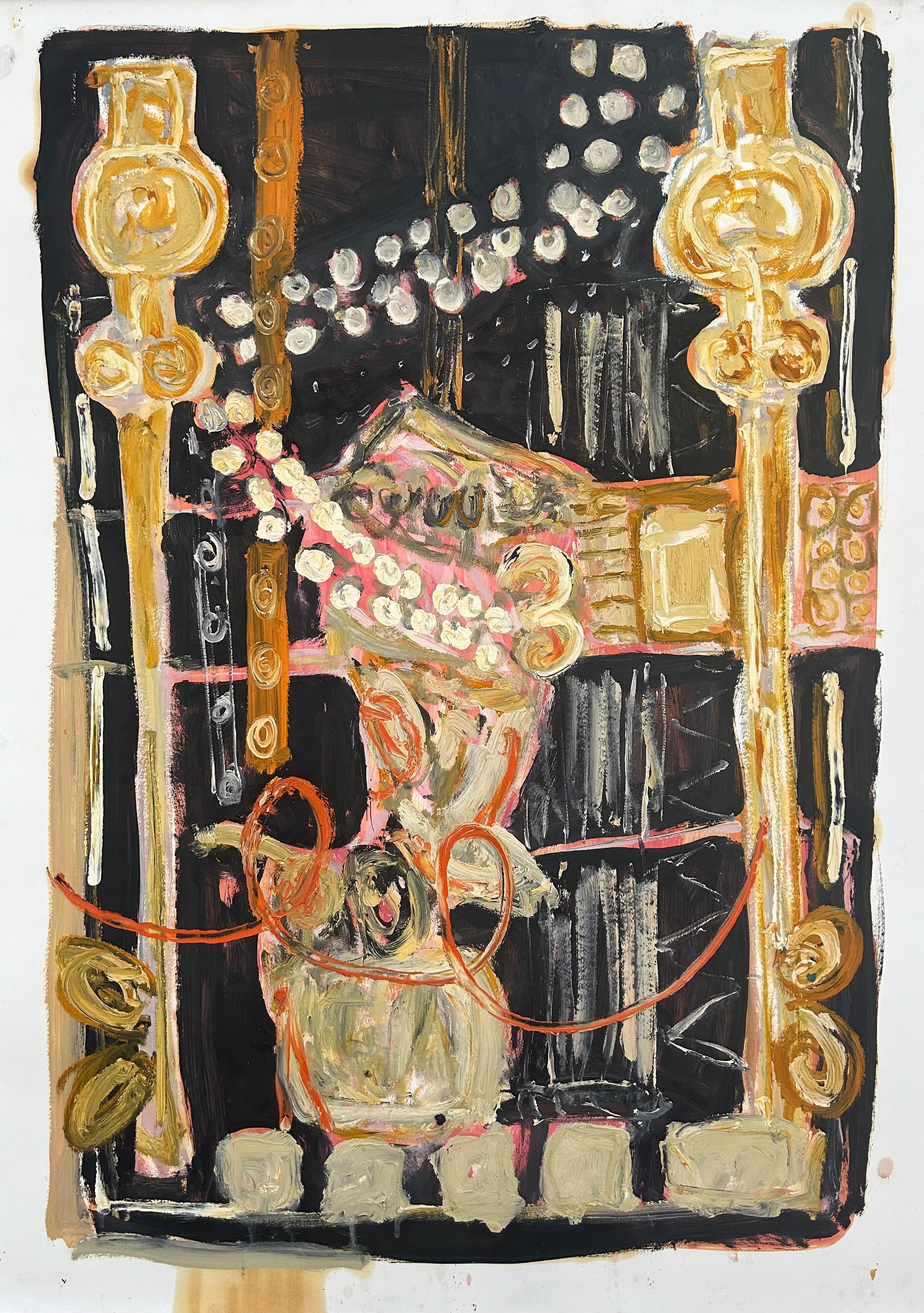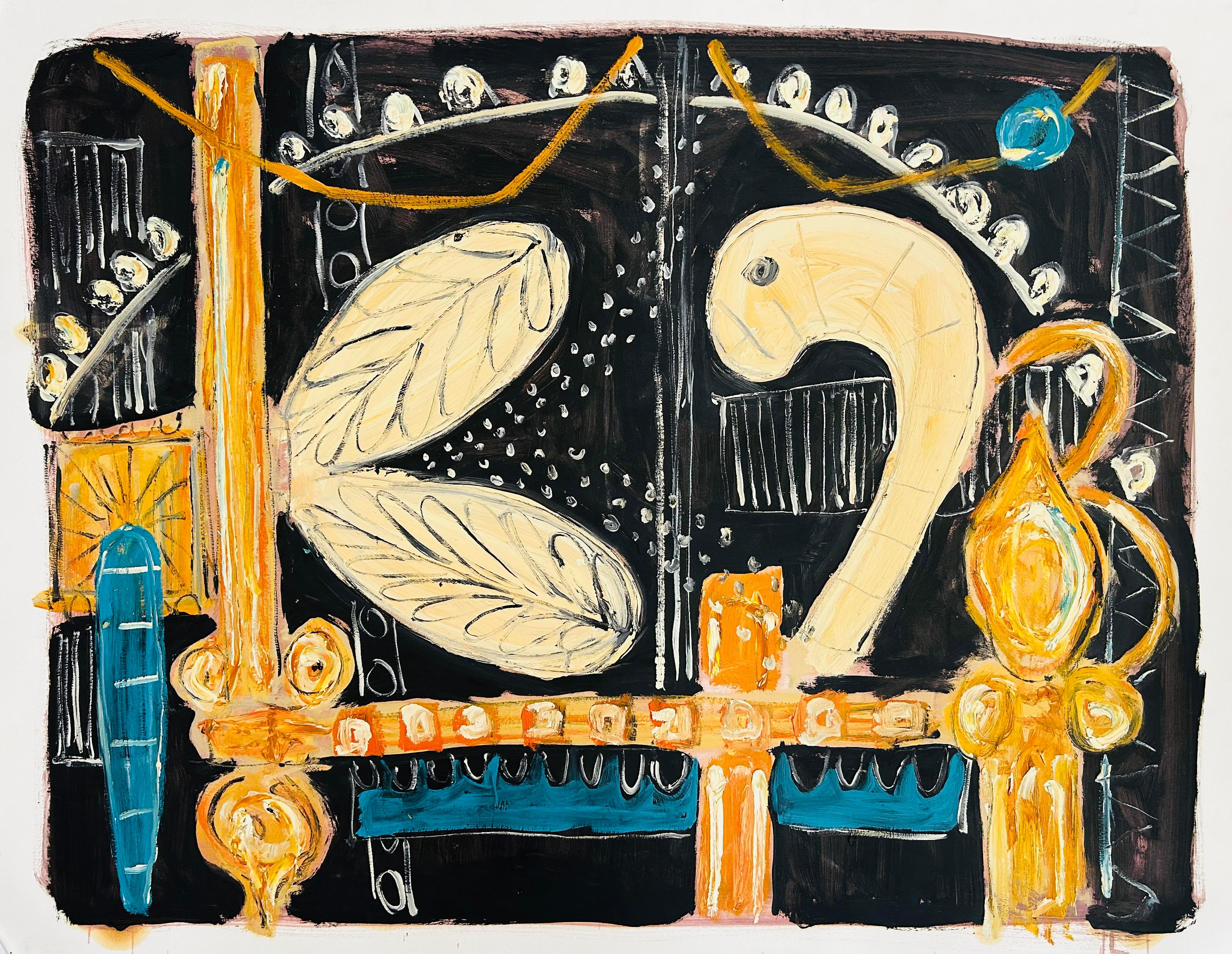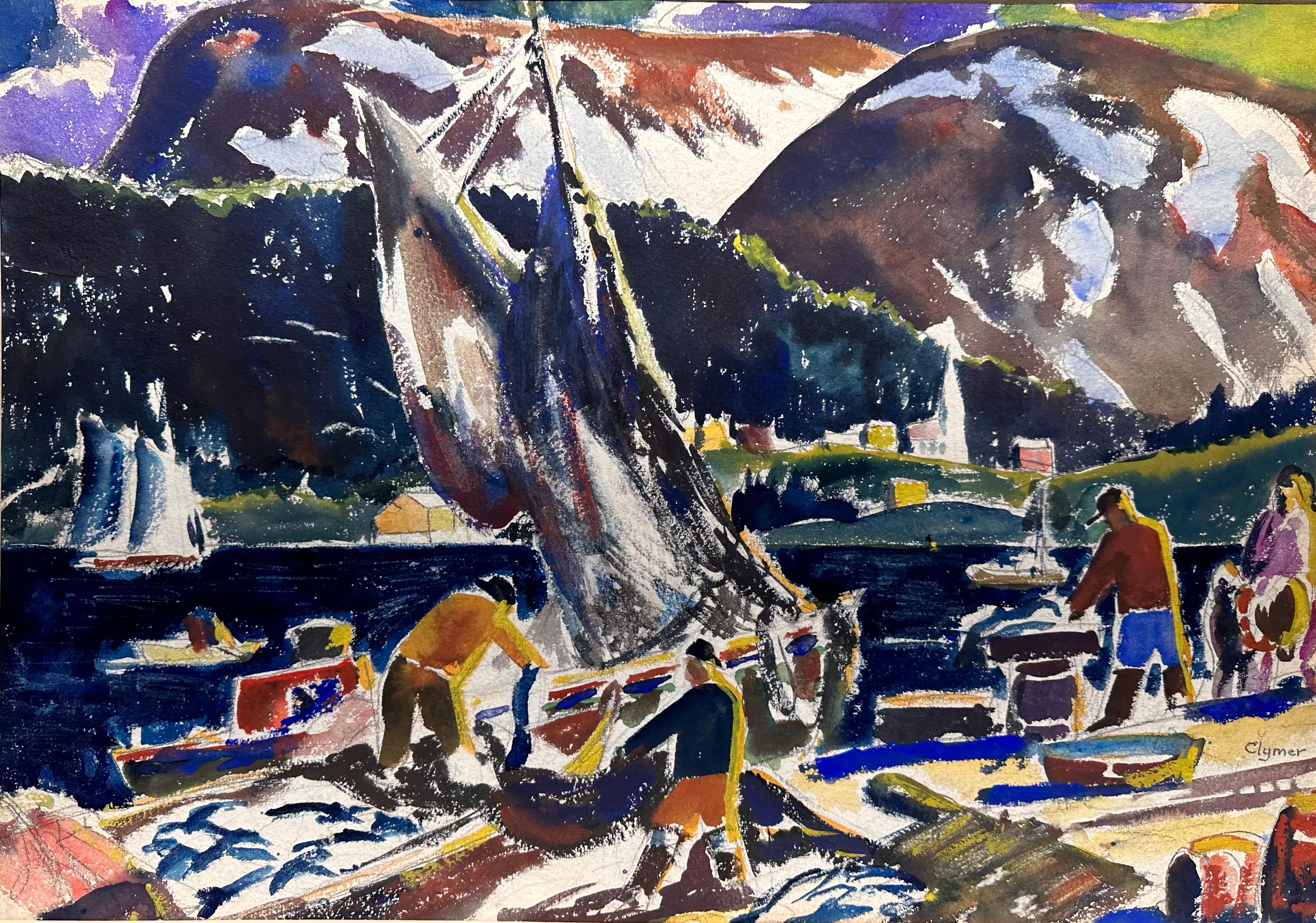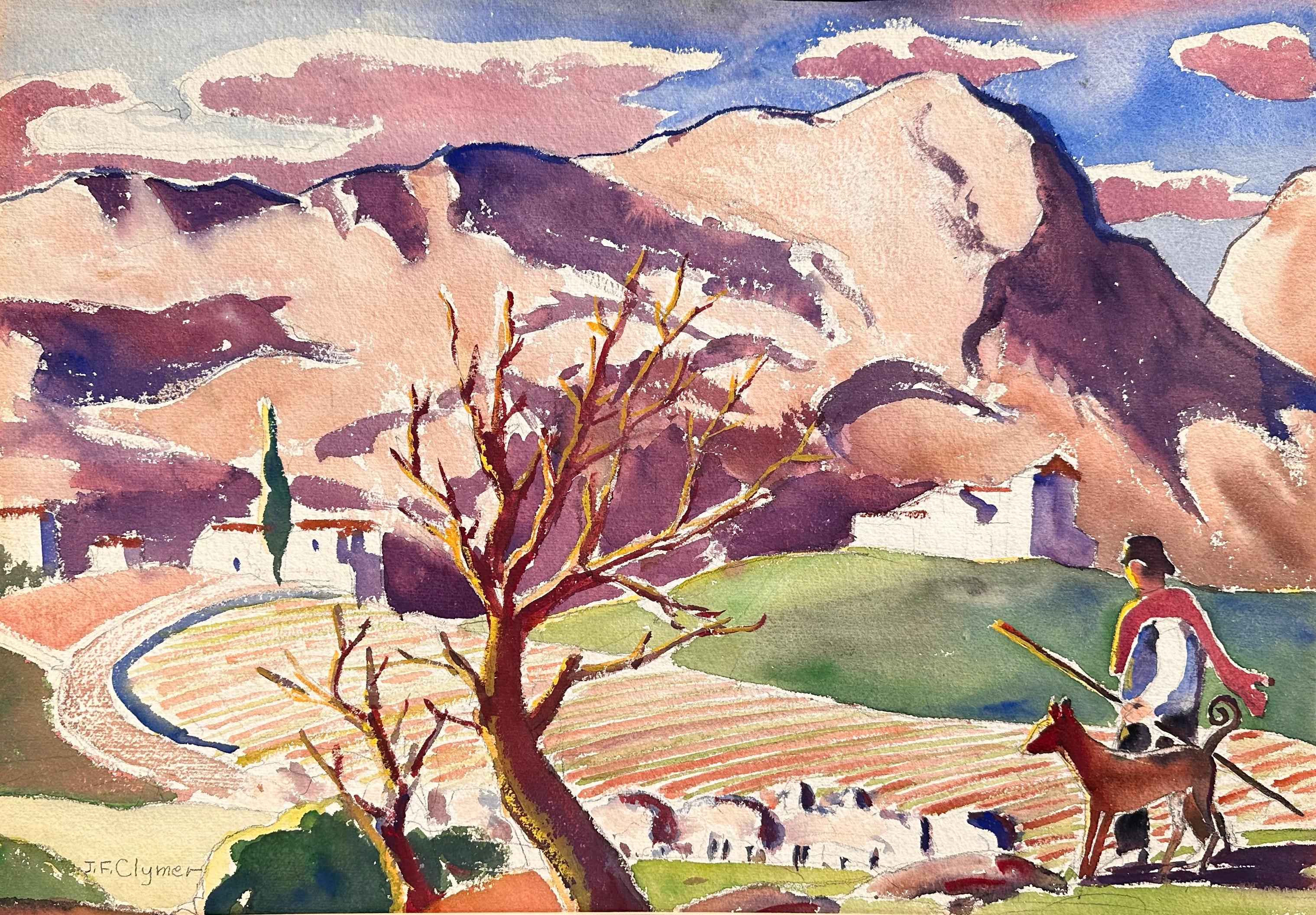Items Similar to The Battle
Want more images or videos?
Request additional images or videos from the seller
1 of 8
Tom Irizarry StudioThe Battle2021
2021
About the Item
It is only after we emerged from the horrible Pandemic, that we realized what a battle it was for simple daily living. Tom created The Battle a few years into the Pandemic.
The picture evokes a struggle taking place.
Paint is vigorously applied in The Battle. It's surface is just as exciting as the image.
Dark clouds hauntingly glow, as bright light shoots out in great brilliance behind them. Lightness and darkness, battle each other, in this skyscape drama.
The clouds are comprised of natural ash and lapis lazuli pigment. Forceful, lapis, clouds threaten.
Powerful, protective malachite green pigment creates a new dimension in The Battle.
Tom uses black touch drawing to echo the energy and chaos in the scene, and the power of the mineral pigments.
The Battle was recently included in the exhibition, USED, The Attleboro Arts Museum, Attleboro MA, July 2023.
- Creator:Tom Irizarry Studio (1958, American)
- Creation Year:2021
- Dimensions:Height: 26 in (66.04 cm)Width: 33.5 in (85.09 cm)Depth: 1.5 in (3.81 cm)
- More Editions & Sizes:9 x 12Price: $1
- Medium:
- Movement & Style:Tonalist
- Period:
- Condition:
- Gallery Location:Chicago, IL
- Reference Number:1stDibs: LU2585212773502
About the Seller
No Reviews Yet
Vetted Seller
These experienced sellers undergo a comprehensive evaluation by our team of in-house experts.
Established in 2000
1stDibs seller since 2023
- ShippingRetrieving quote...Ships From: Chicago, IL
- Return PolicyA return for this item may be initiated within 14 days of delivery.
More From This SellerView All
- VotiveBy Tom Irizarry StudioLocated in Chicago, IL“… look into the stains of walls, or the ashes of a fire, or clouds, or mud … you may find really marvelous ideas. The mind of the painter is stimulated to new discoveries … various ...Category
2010s Modern Landscape Paintings
MaterialsUnderglaze, Oil, Wood Panel
- Brooklyn 1990By Tom Irizarry StudioLocated in Chicago, ILOne of the tallest buildings in Brooklyn was The Williamsburg Savings Bank. I was always fond of this beautiful bank adorned in blue and multi colored tiles in it's lavish hallway....Category
2010s Expressionist Landscape Paintings
MaterialsOil, Pigment
- County Mayo BeachBy Tom Irizarry StudioLocated in Chicago, ILThis painting is one of the finest examples of Tom's painting style and materials. Color and paint burst across the canvas, imbued with movement of clouds, sun and water. From a distant shore, County Mayo...Category
2010s Expressionist Landscape Paintings
MaterialsCanvas, Oil, Pigment
- Brooklyn Blue SkyBy Tom Irizarry StudioLocated in Chicago, ILOne calm evening in Brooklyn. One timeless painting. This scene captures the downtown Brooklyn skyline. A blue sky swirls around the last hurrah of daylight. It soothes the menacing drama of the storm cloud. Brooklyn Blue Sky...Category
2010s Naturalistic Landscape Paintings
MaterialsPigment, Oil
- County Mayo January SunsetBy Tom Irizarry StudioLocated in Chicago, ILThe simplicity of the mountains, with water and bright sky, caught my attention in this scene. Bits of land in the foreground, highlighted by mirror- like reflections, create a plea...Category
2010s Expressionist Landscape Paintings
MaterialsCanvas, Pigment, Oil
- Brooklyn Blaze 1986By Tom Irizarry StudioLocated in Chicago, ILBack in the day, the glorious 1980's was a time of unequaled freedom, that we once took for granted. This picture captures the sky ablaze of a hot summer day - sunset over Downtown B...Category
2010s Expressionist Landscape Paintings
MaterialsOil, Pigment
You May Also Like
- Ray Kass, Still Life 1-05-2015, abstract mixed media watercolor painting, 2015By Ray KassLocated in New York, NYRay Kass uses watercolor and other media to represent the processes of nature at work in his painting, "Still Life 1-05-15," 2015. In his garden and landscape...Category
21st Century and Contemporary Abstract Abstract Paintings
MaterialsWatercolor, Rag Paper, Pigment
- British Abstraction oil on paperboard Alec Cumming Temple Red Orange BlackLocated in Norfolk, GBArtist: Alec Cumming Title: To the Sound of the Temple Medium: oil on paper Size: 97 x 63 cm (38 x 25") Year: 2016 Alec Cumming Exhibited at Alec Cummin...Category
2010s Abstract Abstract Paintings
MaterialsOil, Rag Paper
- British Abstraction oil on paperboard Alec Cumming Theatre Blue Orange BlackLocated in Norfolk, GBArtist: Alec Cumming Title: The Theatre of Wonder Medium: oil on paper Size: 63 x 83 cm (25 x 32.5") Year: 2016 Alec Cumming Exhibited at Alec Cumming, ...Category
2010s Abstract Abstract Paintings
MaterialsOil, Rag Paper
- North on West Street (West Side Highway NYC Cityscape)By De Hirsch MargulesLocated in Wilton Manors, FLDe Hirsh Margules (1899-1965). North on West Street , 1939. Watercolor on Arches wove paper. Signed and dated in pencil by artist lower margin. Sheet measures 15 x 22 inches. Framed measurement: 27 x 34 inched. Incredibly vibrant and saturated color with no fading or toning of sheet. Provenance: Babcock Galleries, NYC De Hirsh Margules (1899–1965) was a Romanian-American "abstract realist" painter who crossed paths with many major American artistic and intellectual figures of the first half of the 20th century. Elaine de Kooning said that he was "[w]idely recognized as one of the most gifted and erudite watercolorists in the country". The New York Times critic Howard Devree stated in 1938 that "Margules uses color in a breath-taking manner. A keen observer, he eliminates scrupulously without distortion of his material." Devree later called Margules "one of our most daring experimentalists in the medium" Margules was also a well-known participant in the bohemian culture of New York City's Greenwich Village, where he was widely known as the "Baron" of Greenwich Village.[1] The New York Times described him as "one of Greenwich Village's best-known personalities" and "one of the best known and most buoyant characters about Greenwich Village. Early Life De Hirsh Margules was born in 1899 in the Romanian city of Iași (also known as Iasse, Jassy, or Jasse). When Margules was 10 weeks old, his family immigrated to New York City. Both of his parents were active in the Yiddish theater, His father was Yekutiel "Edward" Margules, a "renowned Jewish actor-impresario and founder of the Yiddish stage." Margules' mother, Rosa, thirty-nine years younger than his father, was an actress in the Yiddish theater and later in vaudeville. Although Margules appeared as a child actor with the Adler Family[11] and Bertha Kalich, his sister, Annette Margules, somewhat dubiously continued in family theater and vaudeville tradition, creating the blackface role of the lightly-clad Tondelayo (a part later played on film Hedy Lamarr) in Earl Carroll's 1924 Broadway exoticist hit, White Cargo. Annette herself faced stereotyping as an exotic flower: writing about her publicist Charles Bouchert stated that "Romania produces a stormy, temperamental type of woman---a type admirably fitted to portray emotion." His brother Samuel became a noted magician who appeared under the name "Rami-Sami." Samuel later became a lawyer, representing magician Horace Goldin, among others. A family portrait including a young De Hirsh, a portrait of Rosa and Annette together, and individual photos of Rosa and Edward can be found on the Museum of the City of New York website. At around age 9 or 10, Margules took art classes with the Boys Club on East Tenth Street, and his first taste of exhibition was at a student art show presented by the club. By age 11, he had won a city-wide prize (a box camera) at a children's art show presented by the department store Wanamakers. As a young teenager, Margules was already displaying a characteristic kindness and loyalty. Upon hearing that two friends (one of them was author Alexander King), were in trouble for breaking a school microscope, the nearly broke Margules gave them five dollars to repair the microscope . Margules had to approach a wealthy man that Margules had once saved on the subway from a heart attack. Margules didn't reveal the source of the five dollars to King until twenty-five years later. In his late teens, Margules studied for a couple of months in Pittsburgh with Edwin Randby, a follower of Western painter Frederic Remington. Thereafter he pursued a two-year course of studies in architecture, design and decoration at the New York Evening School of Art and Design, while working as a clerk during the day at Stern's Department Store. He was encouraged in these artistic pursuits by his neighbor, the painter Benno Greenstein (who later went by the name of Benjamin Benno). Artistic career In 1922, Margules began work as a police reporter for the City News Association of New York .Margules then considered himself something of an expert on art, and the painter Myron Lechay is said to have responded to some unsolicited analysis of his work with the remark "Since you seem to know so much about it, why don't you paint yourself?" This led to study with Lechay and a flurry of painting. Margules' first show was in 1922 at Jane Heap's Little Review Gallery. Thereafter Margules began to participate in shows with a group including Stuart Davis, Jan Matulka, Buckminster Fuller (exhibiting depictions of his "Dymaxion house") in a gallery run by art-lover and restaurateur Romany Marie on the floor above her cafe. Jane Heap, left, with Mina Loy and Ezra Pound During the 1920s, Margules traveled outside of the country a number of times. In 1922, with the intent of reaching Bali, he took a job as a "'wiper on a tramp steamer where [he] played nursemaid to the engine." He reached Rotterdam before he turned back. He would return to Rotterdam shortly thereafter. In 1927, Margules took a lengthy leave of absence from his day job as a police reporter in order to travel to Paris, where he "set up a studio in Montmartre's Place du Tertre, on the top floor of an almost deserted hotel, a shabby establishment, lacking both heat and running water." He studied at the Louvre and traveled to paint landscapes in provincial France and North Africa. Margules also joined the "Noctambulist" movement and experimented with painting and showing his artwork in low light.Jonathan Cott wrote that: the painter De Hirsch Margulies sat on the quays of the Seine and painted pictures in the dark. In fact, the first exhibition of these paintings, which could be seen only in a darkened room, took place in [ Walter Lowenfels'] Paris apartment. Elaine de Kooning remarked that studying the works of the Noctambulists confirmed Margules' "direction toward the use of primary colors for perverse effects of heavy shadow." It was also in Paris that Margules initially conceived his idea of "Time Painting", where a painting is divided into sectors, each representing a different time of day, with color choices meant to evoke that time of day. In Paris, his social circle included Lowenfels, photographer Berenice Abbott, publisher Jane Heap, composer George Anthiel, sculptor Thelma Wood, painter André Favory, writer Norman Douglas, writer and editor George Davis, composer and writer Max Ewing, and writer Michael Fraenkel. Upon his return to New York in 1929, Margules attended an exhibition of John Marin's paintings. While at the exhibition, he "launched into an eloquent explanation of Marin to two nearby women", and was overheard by an impressed Alfred Stieglitz. The famous photographer and art promoter invited Margules to dine with his wife, the artist Georgia O'Keeffe, and his assistant, painter Emil Zoler. Stieglitz thereafter became a friend and mentor to Margules, becoming for him "what Socrates was to his friends." Alfred Stieglitz Stieglitz introduced Margules to John Marin, who quickly became the most important painterly influence upon Margules. Elaine de Kooning later noted that Margules was "indebted to Marin and through Marin to Cézanne for his initial conceptual approach - for his constructions of scenes with no negative elements, for skies that loom with the impact of mountains." Margules himself said that Marin was his "father and ... academy." The admiration was by no means unreciprocated: Marin said that Margules was "an art lover with abounding faith and sincerity, with much intelligence and quick seeing." Stieglitz also introduced Margules to many other artistic and intellectual figures in New York. With the encouragement of Alfred Stieglitz, Margules in 1936 opened a two-room gallery at 43 West 8th Street called "Another Place." Over the following two years there were fourteen solo exhibitions by Margules and others, and the gallery was well-respected by the press. It was in this gallery that the painter James Lechay, Myron's brother, exhibited his first painting. In 1936, Margules first saw recognition by major art museums when both the Museum of Modern Art and the Museum of Fine Arts, Boston purchased his works. In 1942, Margules gave up working as a police reporter, and apparently dedicated himself thereafter solely to an artistic vocation. "The Baron of Greenwich Village"[edit] Margules made his mark not only as an artist, but also as an outsized personality known throughout Greenwich Village and beyond. To local residents, Margules was known as the "Baron", after Baron Maurice de Hirsch, a prominent German Jewish philanthropist. Margules was easily recognizable by the beret he routinely wore over his long hair. Writer Charles Norman said that he "dressed with a flair for sloppiness." He was said to "know everybody" in Greenwich Village, to the extent that when the novelist and poet Maxwell Bodenheim was murdered, Margules was the first one the police sought to identify the body. Margules' letters show him interacting with art world figures such as Sacha Kolin, John Marin and Alfred Stieglitz, as well as with prominent figures outside the art world such as polymath Buckminster Fuller and writer Henry Miller. Most of his friends and acquaintances found Margules a generous and voluble man, given to broadly emotionally expressive gestures and acts of kindness and loyalty. In 1929, he exhibited an example of this loyalty and fellow-feeling when he appeared in court to fight what the wrongful commitment of his friend, writer and sculptor Alfred Dreyfuss, who appeared to have been a victim of an illicit attempt to block an inheritance. The Greenwich Village chronicler Charles Norman described the bone-crushing hugs that Margules would routinely bestow on his friends and acquaintances, and speaks of the "persuasive theatricality" that Margules seemed to have inherited from his actor parents. Norman also wrote about Margules' routine acts of kindness, taking in homeless artists, constantly feeding his friends and providing the salvatory loan where needed. Norman also notes that Margules was blessed with a loud and good voice, and was apt to sing an operatic air without provocation. The writer and television personality Alexander King said I think the outstanding characteristics of my friend's personality are affirmation, emphasis, and overemphasis. He chooses to express himself predominantly in superlatives and the gestures which accompany his utterances are sometimes dangerous to life and limb. Of the bystanders, I mean. King also spoke with affectionate amusement about Margules' pride in his cooking, speaking of how "if he should ever invite you to dinner, he may serve you a hamburger with onions, in his kitchen-living room, with such an air of gastronomic protocol, such mysterious hints and ogliing innuendoes, as if César Ritz and Brillat-Savarin had sneaked out, only a moment before, with his secret recipe in their pockets." Margules was such a memorable New York personality that comic book writer Alvin Schwartz imagined him at the Sixth Avenue Cafeteria in a risible yet poignant debate with Clark Kent about whether Superman had the ability to stop Hitler. Margules' entrenchment in the Greenwich Village milieu can be seen in a photograph from Fred McDarrah's "Beat Generation Album" of a January 13, 1961 writers' and poets' meeting to discuss "The Funeral of the Beat Generation", in Robert Cordier [fr]'s railroad flat at 85 Christopher Street. Among the people in the same photograph are Shel Silverstein...Category
1930s American Modern Abstract Paintings
MaterialsWatercolor, Rag Paper
- Newfoundland Landscape (Canada)By James Floyd ClymerLocated in Wilton Manors, FLBeautiful abstract painting by American artist, James Floyd Clymer (1893-1982). Newfoundland, ca.1930. Watercolor and pencil on paper measures 14 x 20 inches. Signed lower margin. James Floyd Clymer ( 1893-1982 ) known for his Regionalist style of land, sea and cityscapes, created paintings with an emphasis on color and form. His works possess a clear and simple style, easily understood by the masses. Born in Perkasie Pennsylvania, 20 miles north of Philadelphia, Clymer was the youngest of seven children. Losing his mother during childbirth, he was raised by his eldest sister. He attended Drexel University in Philadelphia, studying Art and Architecture and worked as an Architect in the years following World War I. During this time, Clymer met the artist Gwenyth Waugh, daughter of the renowned marine painter, Frederick Judd Waugh. His thrust then changed from Architect to Artist. Together, the couple travelled to destinations such as Spain and Newfoundland, where they gave birth to their only daughter. In the early 1920's, Clymer and family settled in Provincetown, MA and quickly became associated with notable artists such as Helen Sawyer, Edwin Dickinson...Category
Early 20th Century Abstract Abstract Paintings
MaterialsWatercolor, Rag Paper, Pencil
- Mallorca Spain (Spanish Mediterranean landscape)By James Floyd ClymerLocated in Wilton Manors, FLBeautiful abstract painting by American artist, James Floyd Clymer (1893-1982). Mallorca, ca.1930. Watercolor and pencil on paper measures 14 x 20 inches. Signed lower margin. Ships rolled with matting removed. James Floyd Clymer ( 1893-1982 ) known for his Regionalist style of land, sea and cityscapes, created paintings with an emphasis on color and form. His works possess a clear and simple style, easily understood by the masses. Born in Perkasie Pennsylvania, 20 miles north of Philadelphia, Clymer was the youngest of seven children. Losing his mother during childbirth, he was raised by his eldest sister. He attended Drexel University in Philadelphia, studying Art and Architecture and worked as an Architect in the years following World War I. During this time, Clymer met the artist Gwenyth Waugh, daughter of the renowned marine painter, Frederick Judd Waugh. His thrust then changed from Architect to Artist. Together, the couple travelled to destinations such as Spain and Newfoundland, where they gave birth to their only daughter. In the early 1920's, Clymer and family settled in Provincetown, MA and quickly became associated with notable artists such as Helen Sawyer, Edwin Dickinson and the Waughs. About 1940, Clymer moved to New York City, and in 1946, he and his family settled in a home on Schunnemunk Mountain in New York (close to Newburgh, New York, in the Hudson River Valley). He lived there until circa 1978, when he moved to his granddaughter's house near Schenectady, New York, where he later died. Clymer worked with ease in the mediums of watercolor and oil painting, much like James Fitzgerald...Category
Early 20th Century Abstract Abstract Paintings
MaterialsWatercolor, Rag Paper, Pencil
Recently Viewed
View AllMore Ways To Browse
Landscape Ny 19th Century
Landscape Oil Painting 1800s
De Haes
Fredericksburg Texas
Arkansas Sellers
Club Penguin
Carroll Summers
Cheryl Summers
Barbara Swan
Dan Johnson Mexico
St James Bed
Jean Charles Cazin
William Burke
Acrylic Painting Gathering Flowers
Vahe Yeremyan Lilies Paintings
Edwin Edwards
Aesthetic Period Stained Glass Window
Harold Haydon





